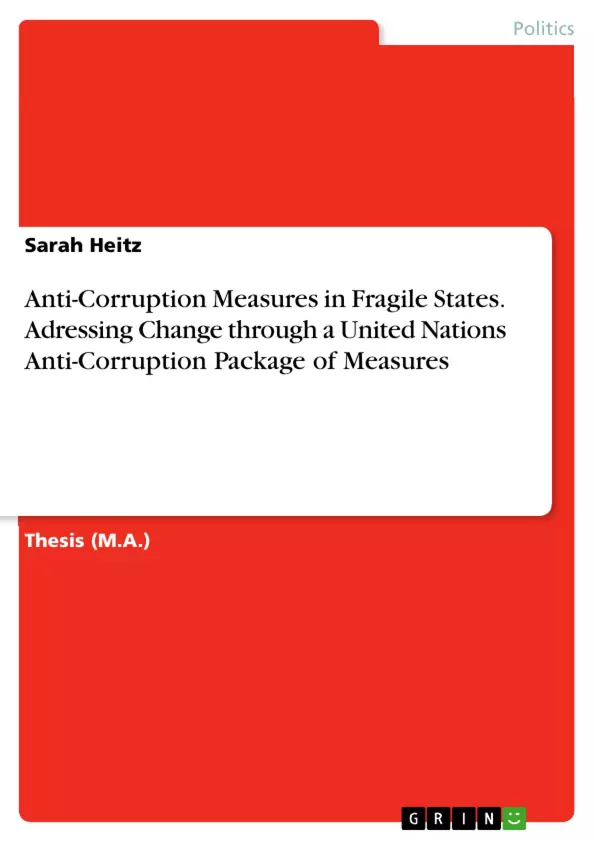Designing and implementing a national anti-corruption strategy is a long-term and expensive undertaking that will almost always require the assistance of the international community. This study does not explicitly provide recommendations for anti-corruption approaches of donors and/or agencies in fragile states, key elements are pointed out where they strongly affect the recipient governments’ political will and capacity for anti-corruption reform. Since the package of measures intends to provide governments with a range of options that enable them to assemble their national strategy, this paper is streamlined to anti-corruption measures in post-emergency or reconstruction phases of emergency situations.
Against the background of corruption, this thesis is based on the following structure; it starts with the international level, followed by the transnational and then national level. It then reverses back through the same levels. Chapter 2 sketches anti-corruption efforts by the international community and integrates them into the larger context of development and intervention policy. In addition the chapter outlines certain features of the UNCAC and depicts the work of the CECS. Due to the complexity of the phenomenon of corruption, chapter 3 provides a general background of corruption and profiles the many aspects of government corruption. It then outlines the (anti-) corruption situation and condition in fragile states, the principles of addressing corruption in such environments and the broader principles of an anti-corruption strategy. Chapter 4 intends to exemplify an anti-corruption approach in one country. It highlights key elements of the anti-corruption strategy to examine how they work in practice and to unveil the complexity of such a strategy. It points out the methodology of the country case study and explains why Sierra Leone was chosen. The historic background and the country’s development, as well as distinctive corruption processes are highlighted. Emphasis is put on assessing anti-corruption action taken by the two Sierra Leonean Governments after the civil war of 1991 to 2002, as well as on donors’ anti-corruption and reconstruction action. Chapter 5 then draws out lessons for tailoring anti-corruption strategies and promotes ideas and recommendations for a UN package of anti-corruption measures for governments of anti-corruption measures for governments in fragile states. Chapter 6 encompasses concluding remarks.
Inhaltsverzeichnis (Table of Contents)
- Introduction.
- The Role of the International Community
- Corruption..
- Corruption: General Background.
- Definition of Corruption ……………………….
- Causes of Corruption..........\li>
- Forms of Corruption.
- Consequences of Corruption.
- Corruption in Fragile States
- The Situation on the Ground.
- Addressing Corruption in Fragile States.
- Effective Anti-Corruption Strategies: One Size Does Not Fit All.
- Corruption: General Background.
- Methodology of the Country Case Study...
- Country Case Study: The Republic of Sierra Leone..\
- The Country: The Republic of Sierra Leone Against the Background of Africa
- Similarities
- Distinctiveness
- Common Cultural and Historic Features...
- Cultural Commonness: The tradition of gift-giving and the primacy of the oral word
- Historical Commonness: The Colonial Background.
- The Republic of Sierra Leone
- General Information …………..\li>
- Historic Background
- The Colonial Era (1808-1961).
- The Post-colonial Era (1961-1990).
- The Civil War (1991-2002)....
- The Reconstruction Phase (2002- now).
- The Kabbah Government (1996, 1998-2007).
- Consolidating Stability.
- Reconstructing the State..
- Institutional Overview.
- Government Activity.
- Donors' Activity.....
- Profiling Corruption and State of Play.
- Assessing the Kabbah Government..\li>
- The Koroma Government (since 2007)...
- Reforming the State.
- Profiling Corruption and State of Play.
- Assessing the Koroma Government...
- Challenges to the Koroma Government..\li>
- Evaluating the Reconstruction and Anti-Corruption Process
- The Kabbah Government (1996, 1998-2007).
- A United Nations Anti-Corruption Package of Measures for Fragile States ...........\
- Outlining the Content of the Package of Measures.
- Pointing out Certain Elements of the Package of Measures
Zielsetzung und Themenschwerpunkte (Objectives and Key Themes)
This thesis analyzes the effectiveness of anti-corruption measures in fragile states, focusing on the case study of Sierra Leone. The central objective is to assess the potential of a comprehensive United Nations Anti-Corruption Package of Measures to address systemic corruption in such contexts.
- The role of the international community in addressing corruption in fragile states.
- The nature and consequences of corruption in fragile states.
- Effective anti-corruption strategies in fragile states.
- A comparative analysis of anti-corruption measures in Sierra Leone.
- The feasibility of a United Nations Anti-Corruption Package of Measures for fragile states.
Zusammenfassung der Kapitel (Chapter Summaries)
- The introduction establishes the research context, outlining the thesis’s objective, key themes, and methodology.
- Chapter two explores the role of the international community in addressing corruption in fragile states, examining the historical context, the changing approaches, and the effectiveness of various international interventions.
- Chapter three defines corruption and examines its different forms, causes, and consequences in a general context. It then focuses on the specific challenges of corruption in fragile states, analyzing the impact of weak governance, civil conflict, and poverty.
- Chapter four presents a case study of Sierra Leone, analyzing its historical background, the impact of civil war, and the reconstruction efforts undertaken since 2002. It investigates the state of corruption in Sierra Leone, assessing the effectiveness of existing anti-corruption measures and identifying challenges for future reforms.
- Chapter five outlines the proposed United Nations Anti-Corruption Package of Measures for fragile states, focusing on its key elements, its potential effectiveness, and its applicability to the case of Sierra Leone.
Schlüsselwörter (Keywords)
Key terms and concepts explored in this thesis include: anti-corruption, fragile states, governance, corruption, civil conflict, poverty, development assistance, international cooperation, United Nations, Sierra Leone, case study, package of measures, institutional reforms, transparency, accountability, rule of law, human rights.
- The Country: The Republic of Sierra Leone Against the Background of Africa
- Citation du texte
- Sarah Heitz (Auteur), 2009, Anti-Corruption Measures in Fragile States. Adressing Change through a United Nations Anti-Corruption Package of Measures, Munich, GRIN Verlag, https://www.grin.com/document/308196



